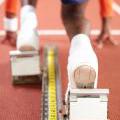
These investigative project ideas challenge students to research world record information and provide opportunities for mathematical modelling and for handling, processing and analysing data. These activities are aimed at GCSE and A Level students (Key Stages 4 and 5).
Project ideas: World Records - Correlations and Predicting the Future
This group of projects is about exploring some of the trends between performances in different sports at the same time in history and in the rate of improvement of records over time.
There is no single simple formula that predicts what the best performance of male or female runners should be over all distances. This is partly because the physiological attributes required to be a good sprinter are quite different from those required to be a good long distance runner. There are also many factors that go into determining who is the best runner at a particular distance, some genetic, some to do with training, some to do with where you have lived and trained during your life.
Faced with this complicated collection of factors, it is useful to look at the data to see if there are any strong patterns in it. Is there a correlation between two different factors? Are there any simple trends about past performance that we can use to predict what might happen in the future? We are going to look for two types of correlation.
Project 1
Find out how the world records for running events have improved over time for both men's and women's events. Plot a graph of the average speed (distance divided by time in units of metres per second) against year from about 1900 until the present for each event in turn (100m, 200m, 400m, 800m, 1500m, 5000m, 10000m, marathon). Also plot the record time for each distance against date for different events. Is there any pattern? Can you predict what the world records might be in 4 years time, 20 years time and 100 years time? How good do you think your predictions are?
Project 2
Do the same kind of analysis as in Project 1, but this time for men's and women's swimming Olympic times.
Project 3
Look at the world record times for flat running events from 100 metres up to the marathon (100m, 200m, 400m, 800m, 1500m, 5000m, 10000m, and the marathon are Olympic events -- you could also add in the records for non-Olympic distances like 1000m, 2000m, 3000m if you like). Do this first for the men's world records and then for the women's world records. Work out the average speed V that is run for each distance.
If you put your data into a spreadsheet, you can use this to work out the average speeds, and then plot a graph of average speed, V, against distance, D. Use XY(Scatter), with the D column on the left of the V column, and add a curved line to the data points. What shape is this graph? Do you think a straight line could be fitted to this data?
To find out what kind of relationship this data displays, right-click on your data line, then select Add Trendline. Select Options first, and check the box for "Display equation on chart" - this will give you an equation for your trendline. Now select the Type tab, and experiment with Linear and Power. Linear will add a straight line to your data line, and you can see whether this is a good fit for the data or not. Power will add a line based on a relationship involving a power of D. Is this better? In each case, the equation of the trendline will be displayed on the graph.
How do the graphs for the men's and women's events compare?
Project 4
Do the same thing for the world freestyle swimming records (50m,100m, 200m, 400m, 800m,1500m) for men and women. Plot the same graphs and compare them to the running records. How do the equations compare? If you have access to any other records for different events, like speed skating or race walking you could compare them in the same way.
Notes and further reading
Wikipedia is a good source of information on world record progressions for athletics and swimming events.
Read more about whether there's an ultimate limit to how low the world record in the 100m will go with the articles 'No Limits for Usain?' on this site and 'How Fast Can We Go?' published on the Maths Careers website.
External project resources
The Royal Statistical Society has produced a set of KS3 and 4 teaching resources on 'Forecasting Human Sporting Achievement'.
These project ideas were originally developed by our Motivate project as follow-up activities to a talk by Professor John D Barrow FRS on 'The Maths Behind the Olympic Games'.

